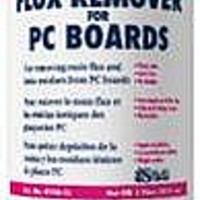4140-400G MG Chemicals, 4140-400G Datasheet

4140-400G
Manufacturer Part Number
4140-400G
Description
Solder, Fluxes & Accessories FLUX REMOVER - PLAST
Manufacturer
MG Chemicals
Type
Flux Removerr
Specifications of 4140-400G
Application
Excellent for removing rosin, non-rosin, no clean fluxes, and ionic contamination
Chemical Component
Ethyl Acetate/Ethanol/Isopropanol
Dispensing Method
Aerosol
Primary Type
Cleaner
Weight
14 Oz.
Description/function
Plastic Safe Liquid Flux Remover
Product
Desoldering Accessories
Size
14 oz
Lead Free Status / RoHS Status
Lead free / RoHS Compliant
������
�����
���
��������������������������������������������������������������������
If you are using flux remover in aerosol form, spray a little flux remover onto the
flux, then agitate with a hog hair cleaning brush. If you are using our 4140 Flux
Remover, you may spray it liberally, as it is safe on your components. If you are
using 413B Heavy Duty Flux remover, you may spray it liberally on the solder side
of the board, but be careful to only apply it directly to the flux contaminated area
if you are using it on the component side of the board, as it will harm some
components. The 4140 is plastic safe so it may be applied liberally. Have a can of
413B handy in case you run into a patch of burnt-on difficult to remove flux.
If you are using flux remover in liquid form, pour the flux remover into a tray. If you
are using 4140 Flux Remover, you may then submerge the PC board into the tray,
agitating the flux with a hog-hair brush. If you are using 413B Heavy Duty Flux
Remover, you should not submerge the board into the tray, as the components will
be damaged. Instead, wet the hog-hair brush you are using by dipping it into the
tray, and then use it to agitate the flux on the board. Periodically rinse and re-wet
the brush by swishing it in the flux remover.
A. The residue in dissolved flux that has not been
washed off the board. Cleaning flux off a circuit board
is more involved than simply spraying a cleaner onto it.
I�P�RTANT�
Removing flux is a two-step process. The first step is dissolving the flux. The
second step is rinsing off the dissolved flux. The rinsing step is very important
because after dissolving the flux it may appear that the solids in the flux have
disappeared, but once the flux remover has evaporated away, the solids will
re-deposit on the board as white residue.
Step 1: Dissolving the Flux
A�����G��Ch��������f��x�r���v�r���r��R�HS�C����������
������������������������
�����������������������
�����������������������
��������������
��������������
������������
��������
��������������
��������������
����������������������������������������������������������#��������
����������������������������������������������������������#��������
����������������������������#
����#����������������������
��������������������
C�������:�Ch��k�,�wh����f��x�r���d������b��rd�
��������������������������v���
�����q��������#���������������
����v����������������
�����������������
�����N�������
��������������������������
�����������������������������
��������������������
����������������������������
4140-400G Summary of contents
Page 1
... Step 1: Dissolving the Flux If you are using flux remover in aerosol form, spray a little flux remover onto the flux, then agitate with a hog hair cleaning brush. If you are using our 4140 Flux Remover, you may spray it liberally safe on your components. If you are ...
Page 2
... Products Discussed Stock Code Product Name 4140-400G Plastic Safe Flux Remover 4140-500ML Plastic Safe Flux Remover 4140-1L Plastic Safe Flux Remover 413B-425G Heavy Duty Flux Remover ...

